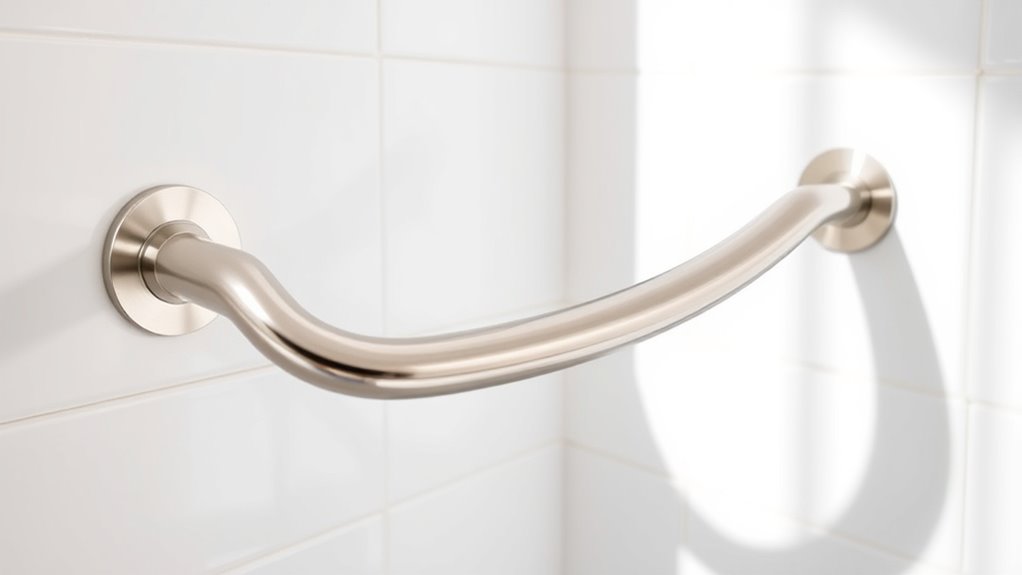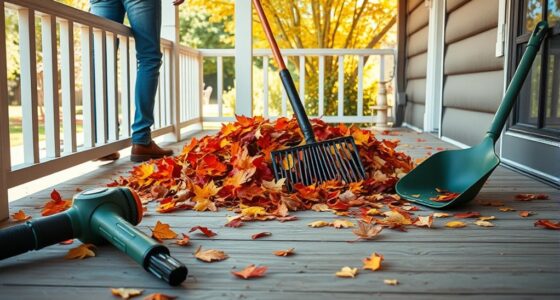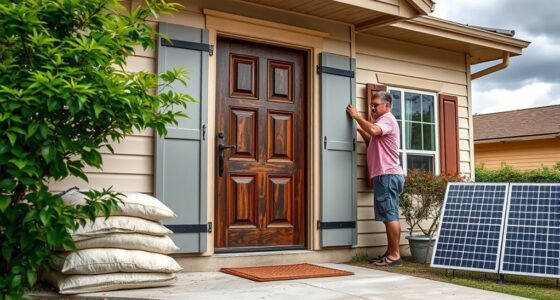When selecting grab bars and handrails for home safety, focus on proper installation, choosing sturdy materials like stainless steel that resist corrosion, and ensuring the right size and design for comfort and grip. Follow manufacturer guidelines for placement height and secure anchoring to prevent loosening. Properly installed, durable grab bars reduce fall risks and provide reliable support, creating a safer environment. Keep exploring to discover how to maximize your safety and satisfaction with the best options.
Key Takeaways
- Choose corrosion-resistant materials like stainless steel or high-quality plastic for durability and safety.
- Follow manufacturer installation instructions to ensure proper placement, anchoring, and support.
- Opt for textured, non-slip surfaces for better grip, especially in wet areas.
- Install grab bars at recommended heights and distances from walls for optimal safety and accessibility.
- Consider professional installation if unsure to guarantee secure, reliable support and prevent accidents.

Ensuring home safety is essential, especially when it comes to preventing falls and injuries in areas like bathrooms and stairways. Choosing the right grab bars and handrails isn’t just about aesthetics; it’s about creating a secure environment where you can move confidently. When selecting these safety features, you need to pay close attention to installation guidelines, which guarantee they’re anchored properly and can support your weight when needed. Proper installation is vital because even the sturdiest grab bar won’t do its job if it’s loose or improperly mounted. Always follow the manufacturer’s instructions carefully—this includes the recommended placement height, distance from the wall, and the type of screws or anchors to use. Using the wrong hardware or installation technique can compromise safety, so if you’re unsure, don’t hesitate to consult a professional.
Proper installation of grab bars ensures safety and stability in your home.
Material durability is another critical factor to contemplate. Grab bars and handrails are subjected to daily use and must withstand moisture, especially in bathrooms where humidity and water exposure are common. Opt for materials that resist corrosion and rust, such as stainless steel or high-quality plastic-coated options. These materials not only last longer but also maintain their strength over time, ensuring ongoing safety. Cheaper or less durable materials might seem cost-effective initially, but they tend to degrade quickly, leading to potential safety hazards and the need for frequent replacements. Remember, the longevity of your grab bars directly impacts your safety, so investing in durable materials is a smart decision.
Additionally, understanding the installation guidelines and how they affect safety is essential for ensuring the grab bars and handrails are effective. When choosing the right grab bars or handrails, consider their design and surface texture. A textured or non-slip surface provides a better grip, especially if your hands are wet or sweaty. The shape matters too; rounded bars are easier to grasp, but some prefer rectangular or contoured designs for added comfort. Think about where you’ll place them—near the toilet, inside the shower, or along staircases—and select sizes and shapes that fit those specific areas. Proper placement combined with sturdy, durable materials enhances safety and gives you peace of mind.
Ultimately, selecting the right grab bars and handrails involves balancing installation guidelines with material durability. When installed correctly with appropriate hardware and placed strategically, these safety features become reliable aids in preventing falls. Choosing high-quality, durable materials ensures they’ll serve you well over time, providing consistent support whenever you need it. Your home should be a safe haven, and taking the time to choose and install the right grab bars and handrails makes a significant difference in reducing injury risks and boosting your confidence in everyday movements.
Frequently Asked Questions
What Are the Best Materials for Grab Bars in Wet Areas?
The best materials for grab bars in wet areas are stainless steel and certain plastics because they offer excellent corrosion resistance and durability. Stainless steel, especially, provides high slip resistance, ensuring safety even when wet. You should choose bars with textured surfaces or non-slip coatings to prevent slips. These materials withstand moisture and maintain grip, making them ideal for bathrooms and other humid spaces.
How Do I Determine the Proper Height for Handrails?
Did you know falls are the leading cause of injury among older adults? To prevent this, you should install handrails at an ergonomic grip height, typically around 34 to 38 inches from the floor. Measure carefully and consider the user’s height and mobility. Proper installation height guarantees a comfortable, secure grip, reducing the risk of falls and increasing safety in your home.
Are There Specific Styles That Blend With Modern Decor?
Yes, there are stylish options that blend seamlessly with modern decor. You can choose decorative grab bars with sleek designs, minimalist shapes, and smooth finishes. Consider options in neutral or matching colors for better color coordination, or opt for finishes like matte black, brushed nickel, or chrome that complement contemporary interiors. These styles provide safety without sacrificing aesthetics, ensuring your home stays both functional and visually appealing.
How Often Should Grab Bars Be Inspected or Replaced?
You should inspect your grab bars and handrails at least once a year as part of your maintenance schedule. Look for looseness, rust, or damage, and replace them promptly if you notice any issues. Typically, a replacement timeline of every 5 to 10 years is suggested to ensure safety. Regular checks help prevent accidents, keeping your home secure and accessible for everyone.
Can I Install Grab Bars Myself or Should I Hire a Professional?
Think of installing grab bars like building a safety net—you want it secure. While DIY installation might seem tempting, it’s best to rely on professional expertise to guarantee safety and proper placement. A skilled installer knows the right anchors and techniques, preventing accidents. So, if you’re unsure or unfamiliar with the process, hiring a professional guarantees your grab bars are safe, sturdy, and ready to support you when needed most.
Conclusion
Choosing the right grab bars and handrails can considerably reduce your risk of falls at home. Did you know that falls are the leading cause of injury among adults over 65? Installing sturdy, properly positioned support can make all the difference in staying safe and independent. Don’t wait until an accident happens—invest in your safety today. Taking simple steps now can give you peace of mind and help you enjoy your home with confidence.









